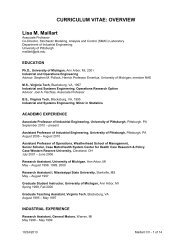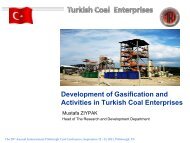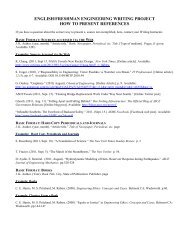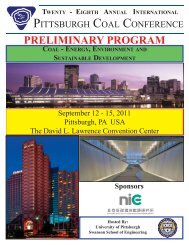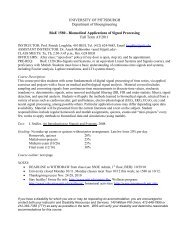Abstract Booklet 2006 - Swanson School of Engineering - University ...
Abstract Booklet 2006 - Swanson School of Engineering - University ...
Abstract Booklet 2006 - Swanson School of Engineering - University ...
Create successful ePaper yourself
Turn your PDF publications into a flip-book with our unique Google optimized e-Paper software.
The Aim <strong>of</strong> the project is the improvement <strong>of</strong> the collaboration in the gas production<br />
and utilization (from various kinds <strong>of</strong> fuels, incl. biomass and their mixtures).<br />
Collaboration between both universities (VŠB-TU Ostrava a SIU Carbondale) was<br />
started at 1993 and there is interest on various themes. Presently is interest on the<br />
“clean gas” production, the special aspect <strong>of</strong> this work is environmental improvement<br />
(minimizing <strong>of</strong> negative people impact to the antroposphere). On the SIU (Southern<br />
Illinois <strong>University</strong>) Carbondale ware gasification engine – pilot with various output –<br />
which can be use for the experiments. Collaboration intensification in the sphere<br />
“clean gas” production and utilization <strong>of</strong> the results in the praxis and teaching process<br />
Special interest <strong>of</strong> the research is given to the estimation <strong>of</strong> main conditions for the gas<br />
production.<br />
22-1<br />
SESSION 22<br />
ENVIRONMENTAL CONTROL TECHNOLOGIES:<br />
SO x , NO x , PARTICULATE AND MERCURY – 2<br />
Effectiveness <strong>of</strong> Clean Coal Technology Provisions <strong>of</strong> EPAct in<br />
Addressing Current Environmental Issues Facing Coal<br />
Ben Yamagata, Coal Utilization Research Council, USA<br />
The Energy Policy Act <strong>of</strong> 2005 (EPAct) includes the enactment <strong>of</strong> numerous programs<br />
designed to encourage the research, development, demonstration and deployment <strong>of</strong> clean<br />
coal technologies. Except for the enactment <strong>of</strong> certain tax incentives designed to benefit<br />
taxpayers utilizing qualifying clean coal technologies all other clean coal programs included<br />
in last year s national energy legislation are authorizations that require appropriations in<br />
order to become effective. The paper will review the various clean coal technology programs<br />
that are included in EPAct and comment upon the rationale and justification cited by<br />
Congress and industry for enactment <strong>of</strong> these provisions. With respect to industry s, and<br />
particularly CURC s, rationale for these various programs, a Clean Coal Technology<br />
Roadmap, first developed by EPRI and CURC, in consultation with the Department <strong>of</strong><br />
Energy, was a guiding document to define what objectives EPAct programs should be<br />
designed to achieve. The Roadmap will be described as well as a discussion as to how the<br />
EPAct programs might support achievement <strong>of</strong> the goals and objectives set forth in the<br />
Roadmap. In order to succeed in achieving the goals <strong>of</strong> EPAct related to clean coal<br />
technologies and to successfully reach the objectives defined in the Roadmap it will be<br />
necessary to fully support the clean coal authorizations <strong>of</strong> EPAct. That is not happening.<br />
Why and what are the potential consequences <strong>of</strong> a lack <strong>of</strong> attention to technology<br />
development especially in light <strong>of</strong> possible regulation <strong>of</strong> carbon dioxide The paper will seek<br />
to answer these questions and particularly will focus on the need for successful technology<br />
development if policy makers choose to create a national or international carbon<br />
management regulatory scheme.<br />
22-2<br />
A Novel Ammonia-Based FGD Process: Experiences <strong>of</strong> a 60MW Demonstration<br />
Wen-De Xiao, East China <strong>University</strong> <strong>of</strong> Science and Technology, P.R. CHINA<br />
More than 70% <strong>of</strong> the energy requirements are met by coal combustion in China, resulting in<br />
severe environmental pollution by huge flue SO 2 discharge over 25 million tones a year. The<br />
well-established and effective procedures to scope with SO 2 and acid rain troubles are flue<br />
gas desulfurization (FGD). But the well-accepted and widely-applied limestone-based FGD<br />
methods have been increasingly blamed where considerable second-hand pollutions<br />
produced. The author and coworkers have been for a decade carried out research for a novel<br />
FGD method, based on ammonia and co-producing a useful fertilizer, ammonium sulfate, as<br />
displayed by: 2NH 3 +SO 2 +H 2 O+0.5O 2 =(NH 4 ) 2 SO 4 It is especially suitable for the Chinese<br />
situations <strong>of</strong> huge ammonia and fertilizer industry. Furthermore, ammonia-based method is,<br />
but limestone-based one is not, accordant to the green chemical principles.<br />
This paper presents the operation experiences with a 60MW demo <strong>of</strong> the newly-developed<br />
ammonia-based FGD process, shown in Figure 1, characterized by a multiple functional<br />
column for SO 2 absorption to ammonium sulfite, sulfite oxidation to sulfate, and sulfate<br />
crystallization. It also overcame shortage <strong>of</strong> the NH 3 slip in the outlet purified gas commonly<br />
appeared in the conventional ammonia-based FGD methods by using two stages in between<br />
NH 3 introduced.<br />
Figure 2 depicts the operational results during a period <strong>of</strong> 168 hours for the evaluation <strong>of</strong> the<br />
method when the inlet flue gas SO 2 content fluctuated between 200 and 1200 ppmv as the<br />
result <strong>of</strong> shifting combusted coal from different mines. The FGD column is very robust for<br />
the SO 2 content variation. The ammonium sulfate resulted met the top-grade fertilizer<br />
specifications.<br />
22-3<br />
Oxy-Firing Flue-Gas Character and Its Effect on FGD -<br />
A Process Study for Integrated Pollutant Removal<br />
Danylo Oryshchyn, Jake Armstrong, Steve Gerdemann, Thomas Ochs, Cathy<br />
Summers, NETL-Albany, USA<br />
The National Energy Technology Laboratory (NETL) is investigating combining oxyfiring<br />
coal, using recirculated flue gas enriched with oxygen, with a unique Integrated<br />
19<br />
Pollutant Removal (IPR) system. Oxy-firing coal produces an exhaust stream<br />
composition dominated by CO 2 and water, with particulate matter and small<br />
contributions <strong>of</strong> SO x , NO x , O 2 , N 2 , Ar, and Hg. This is followed by the IPR system<br />
which uses compression and intercooling to produce a supercritical, transportationready<br />
CO 2 fluid suitable for sequestration or for purification, as necessary, to obtain<br />
CO 2 for industrial use. Recent theoretical and experimental work at NETL is<br />
examining three aspects <strong>of</strong> IPR: acid gas and particulate removal with energy recovery;<br />
water treatment for recycle and release; and the enhancement <strong>of</strong> Hg 0 capture through<br />
oxidation. Because their combination is corrosive, water, associated acid gases and<br />
particulate matter must be removed from the boiler flue gas in the initial stages <strong>of</strong> IPR<br />
to enable compression <strong>of</strong> the remaining CO 2 fluid. This study compared air-fired<br />
furnace exhaust and oxy-fired furnace exhaust in flue gas desulfurization experiments.<br />
Tests indicate the largest effect is associated with the greater concentration <strong>of</strong> SO 2 in<br />
oxy-fired exhaust, despite the high concentration <strong>of</strong> CO 2 in this flue-gas composition.<br />
22-4<br />
Photocatalytic Decomposition <strong>of</strong> NO Originated from Coal Analog Compound<br />
Xue Hanling, Li Jianwei, Ge Lingmei, Zhous Anning, Xi’an <strong>University</strong> <strong>of</strong> Science &<br />
Technology, P.R. CHINA<br />
Nitric oxide (NO) is the major air pollutant that has to be removed before emitting flue<br />
gas into the atmosphere. Various processes, such as the selective catalytic reduction<br />
(SCR) and selective non-catalytic reduction (SNCR), are under operation to remove<br />
NO from flue gas. However, these processes require high operating temperatures and<br />
costs. Recently, a great deal <strong>of</strong> research work has been carried out on the<br />
heterogeneous photocatalytic reactions due to lower energy consumption and operating<br />
cost for treatment <strong>of</strong> polluted water and air. This photocatalytic process has the<br />
advantage <strong>of</strong> complete breakdown <strong>of</strong> organic pollutants to yield CO 2 , H 2 O and the<br />
mineral acid. And studies on photocatalytic decomposition <strong>of</strong> NO have been reported.<br />
It has been found that Cu + /zeolite catalysts exhibit photocatalytic reactivities for the<br />
decomposition <strong>of</strong> NO x into N 2 and O 2 at 275K. In addition, a mixture <strong>of</strong> TiO 2 and<br />
activated carbon is found to be an appropriate photocatalyst for the removal <strong>of</strong> lowconcentration<br />
NO x from air. In the study, the photocatalytic oxidation <strong>of</strong> nitric oxide,<br />
which was the oxidation product stemed from the mold compound pyridine <strong>of</strong> azocycle<br />
compound in coal structure, over mesoporous loaded nanometer photocatalyst<br />
containing metal compounds (MCs) has been studied in a fluidized-bed photoreactor.<br />
Stannic oxide (SnO 2 ), zinc oxide (ZnO), cadmium sulfide (CdS), were used as MCs.<br />
Mesoporous molecule sieve MCM-41 was acted as carrier, and TiO 2 was the primary<br />
photocatalyst. The TiO 2 treated with MC over support MCM-41 by sol-gel method and<br />
dipping process, had the greater efficiency as a NO remover under UV irradiation<br />
compared with monocomponent TiO 2 . It is believed that MCM-41 has a high<br />
adsorptivity for nitric oxide (NO) to contribute to photocatalytic reaction. The amount<br />
<strong>of</strong> NO removed by the loaded photocatalyst including MC showed a tendency to<br />
increase with decreasing initial NO concentration. The reaction rate increased with<br />
reducing UV light wavelength. The NO decomposition activity depended on the<br />
amount <strong>of</strong> semiconductor photocatalysts deposited in channel <strong>of</strong> MCM-41, too, and the<br />
TiO 2 loaded with only 10wt%, meanwhile CdS loaded with only 5%, the photocatalyst<br />
had revealed the highest level <strong>of</strong> activity in the fluidized-bed photoreactor, NO<br />
decomposition reached about 64% at the gas velocity <strong>of</strong> 200ml/min. Highly dispersed<br />
semiconductor photocatalysts in channel <strong>of</strong> MCM-41 was effective for the<br />
photocatalytic decomposition <strong>of</strong> NO.<br />
23-1<br />
SESSION 23<br />
HYDROGEN FROM COAL: SHIFT CATALYST AND GASIFICATION<br />
Robust, Low-Cost Water-Gas Shift Membrane Reactor for<br />
High-Purity Hydrogen Production from Coal-Derived Syngas<br />
Zhijiang Li, Neng Ye, James Torkelson, Aspen Products Group, Inc., USA<br />
In an effort to develop a reliable, low-cost membrane water-gas-shift reactor (WGS)<br />
for hydrogen generation from coal-derived syngas, a sulfur-tolerant transition metal<br />
WGS catalyst and a low-cost, H 2 -selective membrane were developed. Tests conducted<br />
with synthetic syngas containing 3000 ppm sulfur showed that the WGS catalyst is<br />
highly active and capable <strong>of</strong> converting CO at equilibrium conversions at temperatures<br />
from 300 to 500ºC and pressures from 300 to 500 psig. The catalyst displayed higher<br />
WGS activity than a number <strong>of</strong> commercial catalysts, especially at lower temperatures.<br />
The stability <strong>of</strong> the catalyst in the presence <strong>of</strong> 3000 ppm H 2 S and 350 ppm HCl was<br />
demonstrated for >200 hours. The H 2 -selective, high-temperature membrane is based<br />
on a low-cost, hydrogen-selective material. The surfaces <strong>of</strong> the membrane were<br />
modified by deposition <strong>of</strong> catalyst layers <strong>of</strong> desired compositions. H 2 permeation tests<br />
conducted at 300-500ºC and up to 200 psi H 2 partial pressure showed that the<br />
membrane is highly selective to H 2 with a H 2 permeability in the range <strong>of</strong> 1×10 -8 to<br />
1×10 -7 mol H 2 /(m·s·Pa 0.5 ), comparable to that <strong>of</strong> Pd-based membranes. Surface<br />
modification increases not only the membrane’s H 2 permeability but also its tolerance<br />
to H 2 S.



